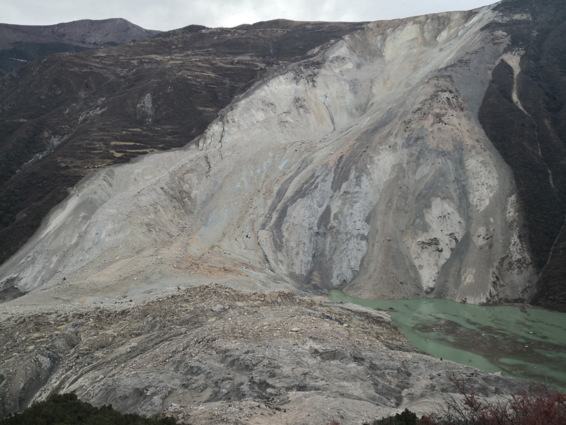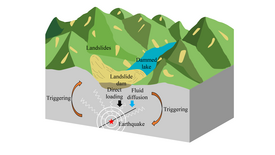08.04.2024 | Fabienne Frey | WSL News
Earthquakes are well-known to trigger surface hazards and initiate hazard cascades. The question whether these events can occur the other way around has remained unexplored so far. A new study co-led by the Swiss Federal Institute for Forest, Snow and Landscape Research WSL found that landslides can cause earthquakes if they dam lakes. This result is of great importance for earthquake risk management.
Earthquakes can initiate landslides or rockfalls. If the sediments subsequently block rivers, landslide-dammed lakes (LDL) form. This sequence of events is well researched. A study co-authored by the WSL and published in the journal Nature Communications now shows that the process can also occur the other way around. "We have proved for the first time that earthquakes can be caused by a sequence of natural hazards on the surface," says Fabian Walter, co-author of the study and researcher at WSL.
Suddenly earthquakes where none occurred before ¶
In 2018, a landslide came down near the Baige village on the Tibetan Plateau. Its volume of 25 million cubic meters corresponded to the amount of water 10’000 olympic-size swimming pools contain. The landslide dammed a river and led to the formation of a landslide-dammed lake. Zhen Zhang, lead author of the study, noticed over 60 earthquakes in the following week, which is an unusually high number for the area. Before, earthquakes had been few and weak. Zhang hence began to investigate the connection between the events. In collaboration with the Chinese University of Hong Kong, he and an international team of researchers carried out statistical analyses and modelling. The results proved that the earthquakes occurred due to the dammed lake. The weight of the water changed the stress and water pressure in the earth, which in turn changed the pressure on faults in such a way that the earthquakes occurred (see Figure 2). Accordingly, the filling and emptying of reservoirs have also led to pressure changes that produced earthquakes, as the study shows.
Risk assessment of earthquakes must be adapted ¶
The results of the study have implications for the risk management of earthquakes, particularly in mountainous regions. Walter emphasizes: "Future risk assessments must take into account that interactions between earthquakes and natural hazards on the surface can occur in both directions." This also applies to Switzerland. "The probability of such an event chain is low. However, in Switzerland’s history, we have repeatedly seen catastrophic rock avalanches. In case of an imminent event, the danger associated with a potentially dammed river should be clarified", says Walter. In addition, the volume of glacial lakes is likely to increase with climate change, which could also change the risk of earthquakes.
Always up to date: Subscribe to the WSL Newsletter
Contact ¶
Publication ¶
Zhang, Z., Liu, M., Tan, Y.J. et al. Landslide hazard cascades can trigger earthquakes. Nat Commun 15, 2878 (2024). https://doi.org/10.1038/s41467-024-47130-w
Copyright ¶
WSL and SLF provide image and sound material free of charge for use in the context of press contributions in connection with this media release. The transfer of this material to image, sound and/or video databases and the sale of the material by third parties are not permitted.

